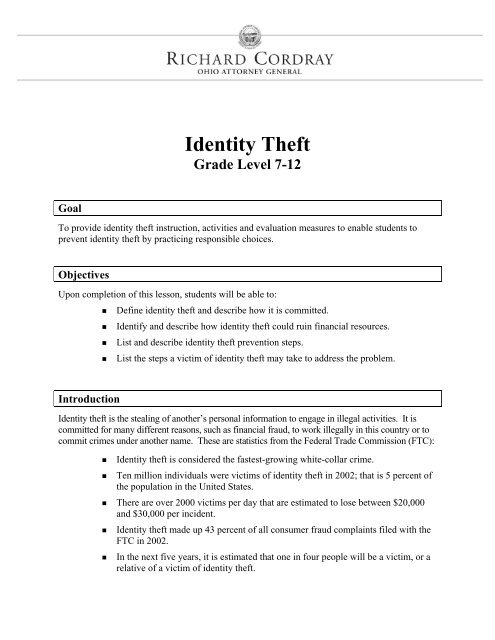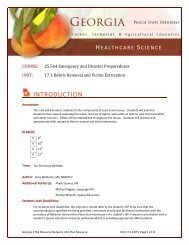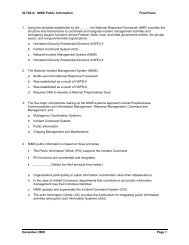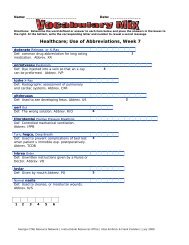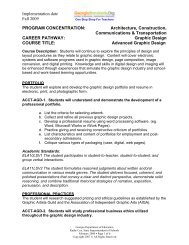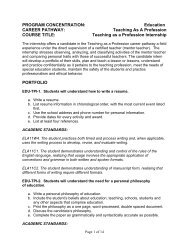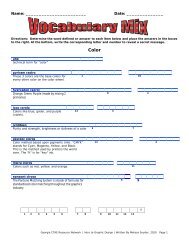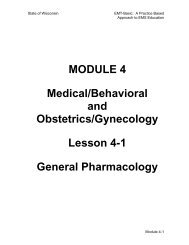ID-Theft-Lesson-Plan
ID-Theft-Lesson-Plan
ID-Theft-Lesson-Plan
You also want an ePaper? Increase the reach of your titles
YUMPU automatically turns print PDFs into web optimized ePapers that Google loves.
Identity <strong>Theft</strong><br />
Grade Level 7-12<br />
Goal<br />
To provide identity theft instruction, activities and evaluation measures to enable students to<br />
prevent identity theft by practicing responsible choices.<br />
Objectives<br />
Upon completion of this lesson, students will be able to:<br />
• Define identity theft and describe how it is committed.<br />
• Identify and describe how identity theft could ruin financial resources.<br />
• List and describe identity theft prevention steps.<br />
• List the steps a victim of identity theft may take to address the problem.<br />
Introduction<br />
Identity theft is the stealing of another’s personal information to engage in illegal activities. It is<br />
committed for many different reasons, such as financial fraud, to work illegally in this country or to<br />
commit crimes under another name. These are statistics from the Federal Trade Commission (FTC):<br />
• Identity theft is considered the fastest-growing white-collar crime.<br />
• Ten million individuals were victims of identity theft in 2002; that is 5 percent of<br />
the population in the United States.<br />
• There are over 2000 victims per day that are estimated to lose between $20,000<br />
and $30,000 per incident.<br />
• Identity theft made up 43 percent of all consumer fraud complaints filed with the<br />
FTC in 2002.<br />
• In the next five years, it is estimated that one in four people will be a victim, or a<br />
relative of a victim of identity theft.
• Victims may spend an average of 175 to 200 hours repairing the damage of an<br />
identity theft incident.<br />
• It is estimated that two-thirds of identity theft incidents go unreported.<br />
• It can take 12 to 14 months before a victim becomes aware their identity has been<br />
stolen.<br />
There are many reasons why being aware of identity theft is important. Personal information is<br />
used in many everyday transactions like writing a check, renting a car, purchasing an airline<br />
ticket, using a cell phone to order a pizza, or applying for a credit card or student loans. Students<br />
can be prime targets for several reasons:<br />
• Many students are concerned with classes, grades, and social activities, and may<br />
not consider the danger around them.<br />
• Students may leave personal information lying around dorm rooms at college.<br />
• Some students lend student <strong>ID</strong>s to their friends.<br />
• Many young adults do not balance checkbooks, keep receipts or check bills before<br />
paying them.<br />
• Some colleges put Social Security numbers on sensitive items, such as student <strong>ID</strong><br />
cards, tests, attendance sheets and grade postings. Some college libraries require<br />
students to input their Social Security number to search, pay fines and use<br />
networks.<br />
Being an identity theft victim can lead to a variety of problems including:<br />
• Being hassled by creditors demanding payments on balances they do not owe.<br />
• Ending up with a ruined credit report.<br />
• Being unable to secure a job, rent an apartment, buy a car or obtain student loans.<br />
• Being arrested for crimes the student did not commit.<br />
Information Used for Identity <strong>Theft</strong><br />
Identity thieves are looking for sensitive personal information about an individual. There are<br />
many pieces of information that could be used. Some of the most common are:<br />
• Social Security number (SSN) — The Social Security number was created in<br />
1935 to keep an accurate record of earnings and pay retirement benefits on those<br />
earnings.<br />
• Date of birth (DOB) —Date of birth, in conjunction with other pieces of<br />
information, can be used in many ways to compromise a person’s identity.
• Current and previous addresses and phone numbers — Both can be used by<br />
an identity thief to pretend they are that person or to obtain more information<br />
about the victim.<br />
• Current and previous employment information — Both can be used to<br />
jeopardize the victim’s identity.<br />
• Financial account information — This includes checking and savings accounts,<br />
credit cards, debit cards, and financial planning information.<br />
• Mother’s maiden name — In many instances, the maiden name of the victim’s<br />
mother may be used as the password for financial accounts and is easily available<br />
through public record information.<br />
Identity theft could be thought of as a puzzle. When assembling a puzzle, pieces fit together to<br />
create a picture. An identity thief is trying to put the pieces of a person’s identity together so<br />
they can impersonate that person. Thieves can get many of the pieces of information above in<br />
many different ways. These ways will be discussed in the next section.<br />
Ways Information Can Be Obtained<br />
Identity thieves can obtain personal information in a variety of ways. A thief may dig through<br />
trash looking for personal information, found on bills, credit card receipts, deposit slips or other<br />
discarded materials. He or she is also interested in the victim’s junk mail, such as pre-approved<br />
credit card offers and convenience checks from a bank. Thieves will steal mail from a victim’s<br />
mailbox. Some complete a change-of-address form to fraudulently receive a victim’s bills and<br />
bank statements. Con artists will scam information over the phone, through the mail and over<br />
the Internet. Stealing a wallet or purse can provide a wealth of information. Sometimes a thief<br />
will watch a victim while they complete a transaction and memorize PIN numbers and<br />
passwords. Information unwittingly supplied to a vanity publication, or for a newspaper or<br />
magazine article, can compromise a person’s identity. An unscrupulous employee with access to<br />
personal information may use the information kept in business records. There is also a wide<br />
variety of information easily obtainable through public records and companies that sell data.<br />
Once the thief has some initial information, he or she can find additional information needed to:<br />
• Apply for a driver’s license.<br />
• Obtain a credit report and use open lines of credit, or open new credit and bank<br />
accounts.<br />
• Obtain cash through financial accounts.<br />
• Purchase a car or other expensive items.<br />
• Take a vacation.<br />
• Get a job.<br />
• Rent an apartment.<br />
• Get a phone or other utility.
• Create counterfeit checks.<br />
• Commit a crime under the stolen name.<br />
• Sell the information to other thieves.<br />
The list could go on and on.<br />
Prevention Tips<br />
The following are tips to help students avoid falling victim to identity theft.<br />
Reduce Access to Personal Data<br />
• Don’t carry unnecessary information in wallets or purses.<br />
• When going to college, don’t leave personal information lying around dorm<br />
rooms. Keep information secure by storing it in a locked file cabinet or small<br />
fireproof safe.<br />
• Don’t lend student <strong>ID</strong>s or other forms of identification.<br />
• Don’t leave mail out for the mail carrier, and use a locked mailbox for incoming<br />
mail.<br />
• Remove name from phone books, reverse directories, etc. Avoid personal<br />
information in vanity publications and public articles.<br />
• Be aware of who is given personal information. When asked to give personal<br />
information to someone, ask why it is needed, how the information is going to be<br />
used, and if there is alternate information that could be provided instead.<br />
Information should not be given to anyone that the consumer does not know.<br />
• Opt out of mail offers with the credit reporting agencies and the Direct Marketing<br />
Association. Information on this is in Attorney General's Protect Yourself Against<br />
Identity <strong>Theft</strong> brochure.<br />
Protecting Credit Cards<br />
• Don’t carry more than one or two credit cards.<br />
• Limit the number of cards used, and cancel unused ones in writing.<br />
• Pass by tables offering freebies to sign up for a credit card — buy a T-shirt<br />
instead.<br />
• Keep a list of credit cards with the account numbers, expiration dates, and phone<br />
numbers of the customer service departments in a secure place in case the cards<br />
are stolen. This information will help when canceling the cards.<br />
• Never give account information over the phone.<br />
• Don’t throw away receipts in public places, and do not leave receipts lying<br />
around.
Keep Passwords and PIN Numbers Secure<br />
• Don’t use the last four digits of a SSN, DOB, middle name, pet’s name or<br />
consecutive numbers, boyfriend or girlfriend’s name, name spelled backwards, or<br />
anything else easy to guess as a password.<br />
• Don’t carry passwords or PIN numbers in a wallet or purse or leave them lying<br />
next to the computer.<br />
• Add extra protection to accounts with an additional password.<br />
• Shield transactions when entering passwords and PIN numbers.<br />
Protecting Social Security Numbers<br />
• Do not give SSNs out to businesses just because they ask for it. There is no law<br />
against asking for a SSN and businesses may have a policy to require it for a<br />
transaction. However, ask why it is needed, what it will be used for, and if there<br />
is alternate information that could use instead. If the answer doesn’t make sense,<br />
don’t do business with the company.<br />
• Request a randomly generated number for student <strong>ID</strong> numbers.<br />
• Place a piece of removable, non-transparent tape over the SSN on identification<br />
cards. Keep these cards secure, and if they are lost or stolen, report it<br />
immediately.<br />
• Do not carry SSNs in a wallet or purse unless absolutely necessary. Keep it in a<br />
secure place.<br />
Some Additional Means of Protection Against Identity <strong>Theft</strong><br />
• Review all billing and account statements promptly.<br />
• Reconcile financial accounts in a timely manner.<br />
• Don’t throw away sensitive material; destroy it. Shred all personal information.<br />
• Beware of sending personal information over the Internet.<br />
• Don’t leave sensitive material in vehicles.<br />
• Regularly review credit reports for suspicious activity.<br />
Information for Students on What to Do if Victimized<br />
The following information may be valuable if a student or student’s family member falls victim<br />
to identity theft.<br />
• File a police report. Keep a log of all conversations including the date and name<br />
of the person spoken with. Follow-up the conversation in writing and send
certified mail with return receipt requested. File a complaint with the Federal<br />
Trade Commission at (877) FTC HELP (382-4357) or www.ftc.gov.<br />
• Victims of identity theft can protect their credit report by contacting the fraud<br />
department of one of the major credit reporting agencies, and adding a victim<br />
statement informing the agency that their account was used fraudulently and they<br />
should be contacted to verify all new accounts. By sending notice to one of the<br />
major credit reporting agencies the victim will automatically be notifying the<br />
other two. Also, they will post a security alert on the credit file within 24 hours<br />
and electronically notify the other two. A fraud alert will be displayed by each<br />
credit reporting agency to all lenders or users. They will opt the victim out of preapproved<br />
offers for two years and mail the victim a copy of his or her credit file.<br />
They will also work with the victim to verify the information and delete any<br />
fraudulent data. Credit reporting agencies are companies that collect and sell<br />
information about the creditworthiness of individuals. The three major credit<br />
reporting agencies are Equifax, Experian, and TransUnion.<br />
• A credit reporting agency collects information that it considers relevant to a<br />
persons credit habits and history. They use this information to assign a credit<br />
score, which indicates how creditworthy a person is. A person's<br />
"creditworthiness" is the degree to which a lender considers a person to be<br />
financially reliable enough to be given credit or lent money, and whether the<br />
lender considers them capable of repaying a loan. The most common measures<br />
used by lenders to determine an individual's creditworthiness are employment<br />
status, the sufficiency of current income to repay the loan, and credit history<br />
obtained from a credit reporting agency.<br />
The toll-free telephone numbers for the Credit Reporting Agencies are:<br />
Experian — (888) EXPERIAN [(888) 397-3742]<br />
Equifax — (800) 525-6285<br />
TransUnion — (800) 680-7289<br />
• Choose passwords that are difficult to guess for all existing accounts. Review<br />
credit reports regularly for suspicious activity. Depending on what has occurred,<br />
there may be other steps to take in order to clear up inaccuracies.<br />
For questions regarding identity theft, or for assistance with companies claiming money is owed<br />
to them that is not, contact Attorney General's Consumer Protection Section at:<br />
Toll-Free: (800) 282-0515 toll-free<br />
Locally: (614) 466-4986<br />
TTY: (614) 995-7147 or (888) 567-6881<br />
30 E. Broad St., 14th Fl.<br />
Columbus, OH 43215-3400<br />
www.ag.state.oh.us
Activities<br />
Activity 1: (Individual or Group Activity) Protecting Your Identity<br />
Break students into small groups or complete the activity with students individually. Ask<br />
students to numerically list the ways that an identity thief may assume another’s identity.<br />
Secondly, ask the students to write beside each answer at least one way they could protect that<br />
information. Have students discuss ways personal information could be used for identity theft.<br />
Ask the students for examples.<br />
Activity 2: Teacher-Directed Personal Information Activity (For grades 11 and 12)<br />
Ask students to look through their wallets, purses, backpacks or other personal belongings to find<br />
all information that may reveal something about their identity. Write on the board the<br />
information categories found to emphasize how many students are carrying items that could be<br />
used in identity theft. Ask the class to describe suggestions to keep the information more secure.<br />
Activity 3: Personal Information In-Class Group Exercise.<br />
Ask each student to complete the, “How Much is Known About You?” handout. After students<br />
have completed the handout, divide the class into pairs. Each pair of students will exchange<br />
papers and compare each other’s answers. Ask the students to name at least one company that<br />
would be interested in the information on the warranty card, referring to the students’ answers.<br />
Instructor Resource Information: “How Much is Known About You?” may be<br />
downloaded from Practical Money Skills’ web site at www.practicalmoneyskills.com.<br />
Activity 4: Group Personal Information Creative Evaluation Activity<br />
Ask students to create a large puzzle out of poster board and markers. In each puzzle piece,<br />
students will write a piece of personal information that a thief could use to steal their identities.<br />
Cut out the puzzle pieces and place them in large zip lock bags. When all groups have finished<br />
their puzzles with their cut- out personal information pieces, ask groups to swap their puzzles<br />
with another group to complete. Puzzle pieces can be taped onto a board for the whole class to<br />
see during the lesson.<br />
Activity 5: Identity <strong>Theft</strong> Scenario Group Activity<br />
Divide the students into small groups. Distribute one Identity <strong>Theft</strong> Scenario Question Card to<br />
each group, asking them to determine what their group would do in each situation. Ask each<br />
group to share their answers with the class.<br />
Instructor Resource Information: Identity <strong>Theft</strong> Scenario Question cards and the<br />
Suggested Answers for Scenario sheets can be downloaded from the Family Financial<br />
Literacy Project at: www.familyfinance.montana.edu.<br />
Activity 6: Identity <strong>Theft</strong> Extension Activity<br />
Ask students to interview a family member or another adult about their knowledge of identity<br />
theft. Students should use interviewing skills and information from identity theft study sheets to<br />
ask the questions and write responses as an extension activity to determine how much knowledge<br />
the person interviewed has about identity theft protection.
Assessment<br />
Have students complete the “What Would You Do” assessment from Practical Money Skills’<br />
website: www.practicalmoneyskills.com.<br />
Materials<br />
• Attorney General’s Protect Yourself Against Identity <strong>Theft</strong> brochure<br />
• “What Your Mail Can Tell You?” from Practical Money Skills<br />
• “What Would You Do?” from Practical Money Skills<br />
• “How Much is Known About You?” from Practical Money Skills<br />
• “Identity <strong>Theft</strong> Scenario Question Cards and Suggested answers for the card questions.<br />
Additional Resources<br />
www.ag.state.oh.us<br />
www.ftc.gov<br />
www.bbb.org<br />
www.consumer.gov/idtheft/<br />
www.practicalmoneyskills.com<br />
www.privacyrights.org/identity.htm<br />
www.usdoj.gov/criminal/fraud/idtheft.html<br />
www.ssa.gov/pubs/idtheft.htm<br />
www.usps.com/postalinspectors/idthft_ncpw.htm<br />
www.familyfinance.montana.edu<br />
http://bmv.ohio.gov/IdentityFraud.html


